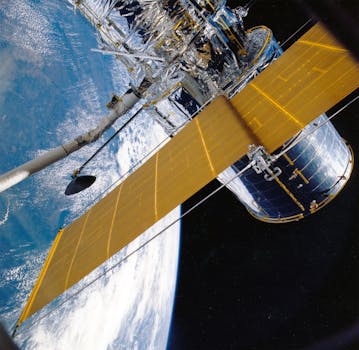The Future of Satellites: Revolutionizing Global Connectivity

The Future of Satellites: Revolutionizing Global Connectivity
The future of satellites is poised to revolutionize global connectivity, enabling faster and more reliable communication networks. With advancements in space technology, satellites are becoming increasingly important for a wide range of applications, from navigation and communication to weather forecasting and Earth observation.
Satellites have been in use for several decades, but recent advancements in technology have made them more accessible and affordable. The launch of small satellites, also known as cubesats, has made it possible for companies and organizations to launch their own satellites into space, enabling a wide range of new applications and services.
Advancements in Satellite Technology
One of the key drivers of the satellite industry is the advancement of technology. New materials and manufacturing techniques have made it possible to build smaller, lighter, and more powerful satellites. This has enabled the development of new types of satellites, such as nanosats and picosats, which are even smaller than cubesats.
Another key area of advancement is in the field of propulsion systems. New types of propulsion systems, such as electric propulsion and advanced ion engines, are being developed, which will enable satellites to travel farther and faster than ever before. This will enable the exploration of new regions of space and the establishment of new satellite constellations.
Applications of Satellites
Satellites have a wide range of applications, from navigation and communication to weather forecasting and Earth observation. One of the most significant applications of satellites is in the field of communication. Satellites enable the transmission of data and voice communications over long distances, making it possible to connect people and devices in remote and underserved areas.
Another key application of satellites is in the field of navigation. Satellites enable the provision of location information and timing signals, which are used in a wide range of applications, from GPS navigation to financial transactions. Satellites are also used for weather forecasting, enabling the prediction of weather patterns and the tracking of severe weather events.
Challenges and Opportunities
Despite the many advancements and applications of satellites, there are also challenges and opportunities that need to be addressed. One of the key challenges facing the satellite industry is the issue of space debris. As more and more satellites are launched into space, the risk of collisions and the accumulation of debris is increasing, which poses a significant threat to the long-term sustainability of space exploration.
Another key challenge facing the satellite industry is the issue of regulatory frameworks. The use of satellites is regulated by a complex array of national and international laws and regulations, which can make it difficult to launch and operate satellites. There is a need for clearer and more consistent regulatory frameworks to enable the development of the satellite industry.
Conclusion
In conclusion, the future of satellites is poised to revolutionize global connectivity, enabling faster and more reliable communication networks. With advancements in space technology, satellites are becoming increasingly important for a wide range of applications, from navigation and communication to weather forecasting and Earth observation. While there are challenges and opportunities that need to be addressed, the potential of satellites to transform our world is vast and exciting.



